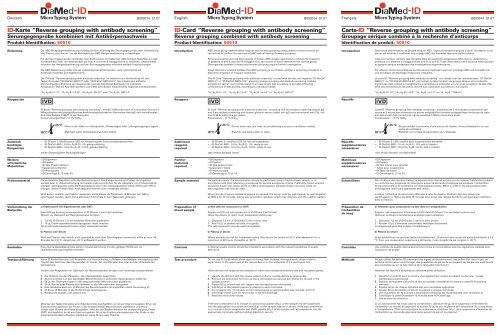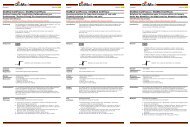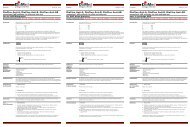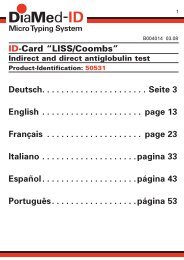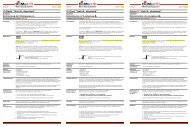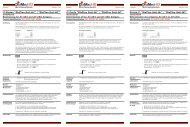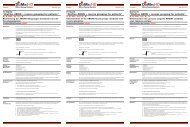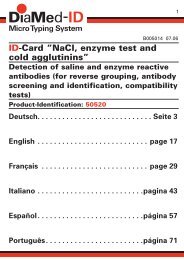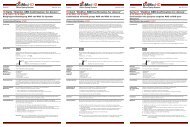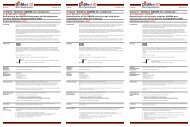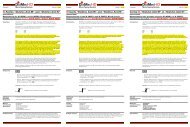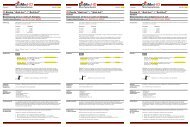ID-Karte “Reverse grouping with antibody screening” ID-Card ...
ID-Karte “Reverse grouping with antibody screening” ID-Card ...
ID-Karte “Reverse grouping with antibody screening” ID-Card ...
- TAGS
- antibody
- diamedil.info
Create successful ePaper yourself
Turn your PDF publications into a flip-book with our unique Google optimized e-Paper software.
Deutsch B003014 01.07 English B003014 01.07 Français B003014 01.07<br />
<strong>ID</strong>-<strong>Karte</strong> <strong>“Reverse</strong> <strong>grouping</strong> <strong>with</strong> <strong>antibody</strong> <strong>screening”</strong><br />
Serumgegenprobe kombiniert mit Antikörpernachweis<br />
Produkt-Identifikation: 50510<br />
Einleitung<br />
Reagenzien<br />
Zuätzlich<br />
benötigte<br />
Reagenzien<br />
Weitere<br />
erforderliche<br />
Materialien<br />
Probenmaterial<br />
Vorbereitung der<br />
Blutprobe<br />
Kontrollen<br />
Testdurchführung<br />
Die ABO-Blutgruppenbestimmung verlangt die Durchführung der Serumgegenprobe unter Verwendung<br />
von Plasma oder Serum, um die Richtigkeit der ABO-Antigenbestimmung zu bestätigen.<br />
Für die Serumgegenprobe verwendet man Erythrozyten mit bekannter ABO-Antigen-Spezifität, um das<br />
Vorhandensein bzw. die Abwesenheit der Anti-A und Anti-B Isoagglutinine zu erkennen. Unterschiede<br />
zwischen der Antigenbestimmung und der Serumgegenprobe erfordern weitere Untersuchungen.<br />
Die ABO-Bestimmung sollte erst als vollständig betrachtet werden, wenn gleichzeitig ein<br />
Antikörper-Suchtest durchgeführt wird.<br />
Die <strong>ID</strong>-<strong>Karte</strong> <strong>“Reverse</strong> <strong>grouping</strong> <strong>with</strong> <strong>antibody</strong> <strong>screening”</strong> ist bestimmt zur Verwendung mit den<br />
Testerythrozyten “<strong>ID</strong>-DiaCell ABO/I-II” oder “<strong>ID</strong>-DiaCell ABO/I-II-III”. Sie erlaubt eine einfache,<br />
gleichzeitige Durchführung der Gegenprobe und des Antikörper-Suchtests (im indirekten<br />
Antiglobulin-Test bei Raumtemperatur) und bietet dem Bedarf entsprechend folgende Kombinationen:<br />
“A 1 -A 2 -B-O / I-II”, “A 1 -A 2 -B / I-II-III”, “A 1 -A 2 -B / EK-I-II” oder “A 1 -A 2 -B / DAT-I-II”.<br />
<strong>ID</strong>-<strong>Karte</strong> <strong>“Reverse</strong> <strong>grouping</strong> <strong>with</strong> <strong>antibody</strong> <strong>screening”</strong>, enthält 3 Mikroröhrchen mit neutralem Gel und 3<br />
Mikroröhrchen mit polyspezifischem Antihumanglobulinserum (Kaninchen-Anti-IgG und monoklonales<br />
Anti-C3d, Zellinie C139-9) in der Gelmatrix.<br />
Konservierungsmittel: < 0,1% NaN 3 .<br />
Nicht in der Nähe von Hitzequellen, Klimaanlagen oder Lüftungsausgängen lagern.<br />
Stabilität: siehe Verfallsdatum auf dem Etikett.<br />
• <strong>ID</strong>-Diluent 2: Modifiziertes LISS zur Herstellung der Erythrozytensuspensionen.<br />
• <strong>ID</strong>-DiaCell ABO / I-II (A 1 -A 2 -B-O / I-II), gebrauchsfertig<br />
• <strong>ID</strong>-DiaCell ABO / I-II-III (A 1 -A 2 -B / I-II-III), gebrauchsfertig<br />
(siehe diesbezügliche Packungsbeilage)<br />
• <strong>ID</strong>-Dispenser<br />
• <strong>ID</strong>-Pipetor<br />
• <strong>ID</strong>-Tips (Pipetorspitzen)<br />
• Suspensionsröhrchen<br />
• <strong>ID</strong>-Arbeitsplatz<br />
• <strong>ID</strong>-Zentrifuge 6, 12 oder 24<br />
Für verlässliche Resultate sollte die Bestimmung mit frisch abgenommenen Proben durchgeführt<br />
werden oder in Übereinstimmung mit lokalen Laborvorschriften für die Akzeptanz von Probenmaterial<br />
erfolgen. Vorzugsweise sollte die Probengewinnung in den Antikoagulantien Citrat, EDTA oder CPD-A<br />
erfolgen. Native Proben (kein Antikoagulanz) können auch verwendet werden.<br />
Wird Serum anstelle von Plasma verwendet, sollte dieses vor Testansatz 10 Minuten bei 1500 g<br />
zentrifugiert werden, damit keine störenden Fibrinreste in dem Testansatz gelangen.<br />
a) Erythrozyten (für Eigenkontrolle oder DAT)<br />
Eine 0,8%ige Erythrozytensuspension in <strong>ID</strong>-Diluent 2 wie folgt herstellen:<br />
Diluent vor Gebrauch auf Raumtemperatur bringen.<br />
1. 1,0 mL <strong>ID</strong>-Diluent 2 in ein sauberes Röhrchen pipettieren.<br />
2. 10 μL Erythrozytenkonzentrat dazugeben, leicht mischen.<br />
Die Erythrozytensuspension kann sofort verwendet werden.<br />
b) Plasma oder Serum<br />
Wird das Plasma oder Serum nicht unmittelbar nach dem Zentrifugieren verwendet, sollte es max. 48<br />
Stunden bei 2-8 °C, danach bei -20 °C aufbewahrt werden.<br />
Eine interne Qualitätskontrolle sollte in Übereinstimmung mit den gültigen Richtlinien zur<br />
Qualitätssicherung mitgeführt werden.<br />
Keine <strong>ID</strong>-<strong>Karte</strong>n benutzen mit Anzeichen von Austrocknung, Luftblasen, beschädigter Versiegelung oder<br />
Tropfen des Gels bzw. des Überstandes im oberen Teil der Mikrokammer oder auf der Unterseite der<br />
Versiegelung.<br />
Proben und Reagenzien vor Gebrauch auf Raumtemperatur bringen und vorsichtig resuspendieren.<br />
1. Die <strong>ID</strong>-<strong>Karte</strong> mit den Patienten- oder Spenderdaten beschriften.<br />
2. Aluminiumfolie von den benötigten Mikroröhrchen in aufrechter <strong>Karte</strong>nposition entfernen.<br />
3. 50 μL der Testerythrozyten in die entsprechenden Mikroröhrchen pipettieren.<br />
4. 50 μL Serum oder Plasma des Patienten in alle Mikroröhrchen dazugeben.<br />
5. Eine Inkubationszeit von 10 Minuten bei Raumtemperatur ist empfohlen (siehe Anmerkung 3).<br />
6. <strong>ID</strong>-<strong>Karte</strong> 10 Minuten in der <strong>ID</strong>-Zentrifuge zentrifugieren.<br />
7. Reaktionen ablesen und aufzeichnen.<br />
Wird bei der Testkombination eine Eigenkontrolle durchgeführt, so ist wie folgt vorzugehen: 50 μL der<br />
Erythrozytensuspension der Probe in das entsprechende Mikroröhrchen pipettieren und 50 μL<br />
Serum oder Plasma der Probe dazugeben. Wird bei der Testkombination ein direkter Antiglobulintest<br />
(DAT) durchgeführt, so ist wie folgt vorzugehen: 50 μL der Erythrozytensuspension der Probe in das<br />
entsprechende Mikroröhrchen pipettieren (ohne Serum oder Plasma).<br />
<strong>ID</strong>-<strong>Card</strong> <strong>“Reverse</strong> <strong>grouping</strong> <strong>with</strong> <strong>antibody</strong> <strong>screening”</strong><br />
Reverse <strong>grouping</strong> combined <strong>with</strong> <strong>antibody</strong> screening<br />
Product-Identification: 50510<br />
Introduction<br />
Reagents<br />
Additional<br />
reagents<br />
required<br />
Further<br />
materials<br />
required<br />
Sample material<br />
Preparation of<br />
blood sample<br />
Controls<br />
Test procedure<br />
ABO blood group determination requires that reverse <strong>grouping</strong> using plasma or serum should be<br />
carried out to confirm the accuracy of ABO red cell typing (forward <strong>grouping</strong>).<br />
Reverse <strong>grouping</strong> uses red cell reagents of known ABO antigen specificity to indicate the presence<br />
or absence of anti-A and anti-B isoagglutinins, the results of which determine the reverse group.<br />
Discrepancies between forward and reverse <strong>grouping</strong> require further investigation.<br />
Good laboratory practice dictates that ABO <strong>grouping</strong> is incomplete <strong>with</strong>out a screening procedure to<br />
detect the presence of irregular antibodies.<br />
The <strong>ID</strong>-<strong>Card</strong> <strong>“Reverse</strong> <strong>grouping</strong> <strong>with</strong> <strong>antibody</strong> <strong>screening”</strong> is used <strong>with</strong> the test cell reagents “<strong>ID</strong>-DiaCell<br />
ABO/I-II” or “<strong>ID</strong>-DiaCell ABO/I-II-III”, allowing reverse <strong>grouping</strong> and <strong>antibody</strong> screening (indirect<br />
antiglobulin test at room temperature) in an easy single test procedure. It provides following<br />
combinations of test profiles, according to individual needs:<br />
“A 1 -A 2 -B-O / I-II”, “A 1 -A 2 -B / I-II-III”, “A 1 -A 2 -B / ac-I-II” or “A 1 -A 2 -B / DAT-I-II”.<br />
<strong>ID</strong>-<strong>Card</strong> <strong>“Reverse</strong> <strong>grouping</strong> <strong>with</strong> <strong>antibody</strong> <strong>screening”</strong> consisting of 3 microtubes containing neutral gel<br />
and 3 microtubes containing anti-human globulin serum (rabbit anti-IgG and monoclonal anti-C3d, cell<br />
line C139-9) <strong>with</strong>in the gel matrix.<br />
Preservative: < 0,1% NaN 3 .<br />
Do not store near any heat, air conditioning sources or ventilation outlets.<br />
Stability: see expiry date on label.<br />
• <strong>ID</strong>-Diluent 2: modified LISS for red cell suspension.<br />
• <strong>ID</strong>-DiaCell ABO / I-II (A 1 -A 2 -B-O / I-II), ready-to-use<br />
• <strong>ID</strong>-DiaCell ABO / I-II-III (A 1 -A 2 -B / I-II-III), ready-to-use<br />
(see related package insert)<br />
• <strong>ID</strong>-Dispenser<br />
• <strong>ID</strong>-Pipetor<br />
• <strong>ID</strong>-Tips (pipetor tips)<br />
• Suspension Tubes<br />
• <strong>ID</strong>-Working table<br />
• <strong>ID</strong>-Centrifuge 6, 12 or 24<br />
For optimal results, the determination should be performed using a freshly drawn sample, or in<br />
accordance <strong>with</strong> local laboratory procedures for sample acceptance criteria. Preferably, blood samples<br />
should be drawn into citrate, EDTA or CPD-A anticoagulant. Samples drawn into plain tubes (no<br />
anticoagulant) may also be used.<br />
When the use of serum instead of plasma is required, the serum must be well cleared, by centrifugation<br />
at 1500 g for 10 minutes, before use avoid fibrin residues, which may interfere <strong>with</strong> the reaction pattern.<br />
a) Red cells (for autocontrol or DAT)<br />
Prepare a 0,8% red cell suspension in <strong>ID</strong>-Diluent 2 as follows:<br />
Allow the diluent to reach room temperature before use.<br />
1. Dispense 1,0 mL of <strong>ID</strong>-Diluent 2 into a clean tube.<br />
2. Add 10 μL of packed red cells, mix gently.<br />
The cell suspension may be used immediately.<br />
b) Plasma or serum<br />
Where samples are not for immediate testing they should be stored at 2-8 °C after separation for a<br />
maximum of 48 hours, thereafter at -20 °C.<br />
A internal quality control should be included in accordance <strong>with</strong> the relevant guidelines of quality<br />
assurance.<br />
Do not use <strong>ID</strong>-<strong>Card</strong>s which show signs of drying, have bubbles, damaged seals, drops of gel or<br />
supernatant in the upper part of the microtubes or on the underside of the aluminium foil.<br />
Allow the test cell reagents and samples to reach room temperature before use and resuspend gently.<br />
1. Identify the <strong>ID</strong>-<strong>Card</strong> <strong>with</strong> the unique patient or donor number/details as appropriate.<br />
2. Remove the aluminium foil from as many microtubes as required by holding the <strong>ID</strong> card in the<br />
upright position.<br />
3. Pipette 50 μL of each test cell reagent into the appropriate microtubes.<br />
4. Add 50 μL of the patient’s serum or plasma to each microtube.<br />
5. An incubation for 10 minutes at room temperature is recommended (see remarks, point 3).<br />
6. Centrifuge the <strong>ID</strong>-<strong>Card</strong> for 10 minutes in the <strong>ID</strong>-Centrifuge.<br />
7. Read and record the results.<br />
If the test combination is to include an autocontrol, pipette 50 μL of the sample red cell suspension<br />
into the appropriate microtube and add 50 μL of the sample plasma or serum. If the test combination<br />
is to include a direct antiglobulin test (DAT), pipette 50 μL of the sample red cell suspension into the<br />
appropriate microtube (<strong>with</strong>out adding plasma or serum).<br />
Carte-<strong>ID</strong> <strong>“Reverse</strong> <strong>grouping</strong> <strong>with</strong> <strong>antibody</strong> <strong>screening”</strong><br />
Groupage sérique combiné à la recherche d’anticorps<br />
Identification de produit: 50510<br />
Introduction<br />
Réactifs<br />
Réactifs<br />
supplémentaires<br />
nécessaires<br />
Matériaux<br />
supplémentaires<br />
nécessaires<br />
Echantillons<br />
Préparation de<br />
l’échantillon<br />
de sang<br />
Contrôles<br />
Méthode<br />
Dans toute détermination de groupe sanguin ABO, l’épreuve sérique pratiquée à partir du plasma ou du<br />
sérum est destinée à confirmer le groupage ABO des hématies (épreuve érythrocytaire).<br />
L’épreuve sérique, utilisant des hématies-tests de spécificité antigénique ABO connue, détermine la<br />
présence ou l’absence d’isoagglutinines anti-A ou anti-B. Toute discordance entre épreuve érythrocytaire<br />
et épreuve sérique nécessitera des investigations supplémentaires.<br />
Par ailleurs, de bonnes pratiques de laboratoire impliquent que tout groupage ABO soit complété par<br />
une procédure de dépistage d’anticorps irréguliers.<br />
La carte-<strong>ID</strong> <strong>“Reverse</strong> <strong>grouping</strong> <strong>with</strong> <strong>antibody</strong> <strong>screening”</strong> est utilisée avec les hématies-tests “<strong>ID</strong>-DiaCell<br />
ABO/I-II” ou “<strong>ID</strong>-DiaCell ABO/I-II-III”, permettant la détermination du groupe sérique et la recherche<br />
d’anticorps (test indirect à l’antiglobuline à température ambiante) en une seule procédure de test. Elle<br />
offre des combinaisons de profils comme suit, répondant aux besoins individuels:<br />
“A 1 -A 2 -B-O / I-II”, “A 1 -A 2 -B / I-II-III”, “A 1 -A 2 -B / ac-I-II” ou “A 1 -A 2 -B / TDA-I-II”.<br />
Carte-<strong>ID</strong> <strong>“Reverse</strong> <strong>grouping</strong> <strong>with</strong> <strong>antibody</strong> <strong>screening”</strong>, constituée de 3 microtubes contenant du gel<br />
neutre et 3 microtubes contenant du sérum antiglobuline humaine polyspécifique (anticorps de lapin<br />
anti-IgG et anti-C3d monoclonal, lignée cellulaire C139-9) inclus dans le gel.<br />
Conservateur: < 0,1% NaN 3 .<br />
Ne pas stocker à proximité d’une source de chaleur, d’une climatisation ou une<br />
sortie de ventilation.<br />
Stabilité: voir la date de péremption sur l’étiquette.<br />
• <strong>ID</strong>-Diluent 2: LISS modifié pour suspensions d’hématies.<br />
• <strong>ID</strong>-DiaCell ABO / I-II (A 1 -A 2 -B-O / I-II), prêt à l’emploi<br />
• <strong>ID</strong>-DiaCell ABO / I-II-III (A 1 -A 2 -B / I-II-III), prêt à l’emploi<br />
(voir mode d’emploi correspondant)<br />
• <strong>ID</strong>-Dispenser<br />
• <strong>ID</strong>-Pipetor<br />
• <strong>ID</strong>-Tips (cônes pour pipette)<br />
• Tubes pour suspensions<br />
• <strong>ID</strong>-Table de travail<br />
• <strong>ID</strong>-Centrifuge 6, 12 ou 24<br />
Afin d’obtenir des résultats fiables, la détermination devrait se faire sur du matériel fraîchement prélevé<br />
ou conforme aux exigences du laboratoire auquel la demande d’analyses est adressée. L’échantillon<br />
devrait être prélevé de préférence sur anticoagulant citrate, EDTA ou CPD-A. Du sang prélevé sans<br />
anticoagulant (natif) peut également être utilisé.<br />
Lorsque l’utilisation de sérum est préférable à celle de plasma, le sérum doit être obtenu par<br />
centrifugation à 1500 g pendant 10 minutes pour éviter des résidus de fibrine qui pourraient interférer<br />
avec la réaction.<br />
a) Hématies (pour autocontrôle ou test direct à l‘antiglobuline)<br />
Préparer une suspension d‘hématies à 0,8% dans <strong>ID</strong>-Diluent 2 en procédant comme suit:<br />
Ramener le diluent à température ambiante avant utilisation.<br />
1. Distribuer 1,0 mL d’<strong>ID</strong>-Diluent 2 dans un tube propre.<br />
2. Ajouter 10 μL d‘hématies concentrées, mélanger doucement.<br />
La suspension peut être utilisée immédiatement.<br />
b) Plasma ou sérum<br />
Si les échantillons ne sont pas testés immédiatement, ils devront être conservés après décantation à 2-8<br />
°C. Pour une conservation supérieure à 48 heures, il est conseillé de les congeler à -20 °C.<br />
Une contrôle de qualité interne devront être inclus en concordance avec les régulations valables pour<br />
l’assurance de qualité.<br />
Ne pas utiliser les cartes <strong>ID</strong> présentant des signes de desséchement, des bulles d‘air dans le gel, un<br />
système de fermeture endommagé, des goutelettes de gel ou de surnageant sur les paroies supérieures<br />
des micotubes ou sur la face interne de la languette d‘aluminium.<br />
Ramener les réactifs à température ambiante avant utilisation.<br />
1. Identifier la carte <strong>ID</strong> avec le numéro d’enregistrement unique du patient ou donneur / toutes<br />
identifications pertinentes.<br />
2. Décoller la languette d‘aluminium des microtubes nécessaires en tenant la carte <strong>ID</strong> en position<br />
verticale.<br />
3. Pipetter 50 μL de chaque hématies-test aux microtubes appropriés.<br />
4. Ajouter 50 μL de plasma ou sérum du patient à chaque microtube.<br />
5. Une incubation de 10 minutes à température ambiante est recommandée (voir remarque 3).<br />
6. Centrifuger la carte-<strong>ID</strong> pendant 10 minutes dans l‘<strong>ID</strong>-Centrifuge.<br />
7. Lire et noter les réactions.<br />
Si un autocontrôle est inclus dans la combinaison, distribuer 50 μL de la suspension d’hématies de<br />
l’échantillon au microtube approprié et ajouter 50 μL de sérum/plasma de l’échantillon. Si un test direct<br />
à l’antiglobuline (TDA) est inclus dans la combinaison, distribuer 50 μL de la suspension d’hématies de<br />
l’échantillon au microtube approprié (sans ajouter de sérum ou plasma).
Français B003014 01.07 English B003014 01.07 Deutsch B003014 01.07<br />
Interprétation des<br />
résultats<br />
Remarques<br />
Limites<br />
Bibliographie<br />
A) Principe<br />
Positif: Hématies agglutinées formant une ligne rouge à la surface du gel ou des<br />
agglutinats dispersés dans le gel.<br />
Négatif: Hématies en culot compact au fond du microtube.<br />
B) Réactions de l‘épreuve sérique<br />
Hématies-Tests Groupe sanguin<br />
A 1 A 2 B O<br />
négatif négatif + à ++++ négatif A<br />
+ à ++++ ± à ++++ négatif négatif B<br />
négatif négatif négatif négatif AB<br />
+ à ++++ + à ++++ + à ++++ négatif O<br />
Note: Pour être complet, un groupage ABO nécessite que l’épreuve érythrocytaire et l’épreuve sérique<br />
soient parfaitement concordantes. En cas de différences, des investigations supplémentaires, seront<br />
nécessaires.<br />
C) Réactions de la recherche d’anticorps<br />
- Des réactions négatives avec toutes les hématies-tests correspondantes indiquent l’absence<br />
d’anticorps détectables.<br />
- Des réactions positives avec une ou plusieures hématies-tests correspondante évoque la présence<br />
d’anticorps irrégulier et des tests supplémentaires sont nécessaires pour préciser la spécificité de<br />
l’anticorps.<br />
- Lorsqu’on observe des réactions positives avec toutes les hématies-tests correspondantes, il<br />
est souhaitable de pratiquer un autocontrôle et des investigations supplémentaires (Recherche<br />
d’anticorps complète à 37 °C), (voir Remarques).<br />
- Lorsqu’un microtube avec antiglobuline est utilisé pour un test direct à l’antiglobuline (TDA) et qu’il<br />
révèle une réaction positive, des investigations supplémentaires sont nécessaires pour en élucider la<br />
cause.<br />
1. Un autocontrôle positif suggère la présence d’un autoanticorps; toutefois, des procédures adéquates<br />
devront être effectuées pour éliminer la présence d’un alloanticorps sous-jacent, dans le<br />
sérum/plasma du patient.<br />
2. Un autocontrôle négatif avec une recherche d’anticorps positive indique la présence d’un<br />
alloanticorps et des procédures d’identification d’anticorps devront être entreprises pour déterminer<br />
la spécificité de l’anticorps.<br />
3. Pour l’épreuve de groupage sérique une incubation d’un minimum de 10 minutes à 18-25 °C avant<br />
centrifugation potentialisera la réaction et réduira le nombre de contrôles dus à des iso agglutinines<br />
faibles.<br />
4. Il est déconseillé de réaliser à température ambiante le dépistage d‘anticorps irrégulier cliniquement<br />
important au cours de la grossesse et chez les receveurs.<br />
a) Les cartes-<strong>ID</strong> présentant des bulles d‘air dans le gel ou des goutelettes dans la partie supérieur des<br />
microtubes ou sur la languette métallique doivent être centrifugées avant utilisation.<br />
b) Les conditions de réaction optimale peuvent varier considérablement d’un type d’anticorps à l’autre.<br />
Par conséquent, une seule technique peut être insuffisante pour détecter tous les anticorps et une<br />
procédure de test combiné devrait être appliquée.<br />
c) Certains médicaments sont connus pour entraîner des tests positifs à l’antiglobuline humaine.<br />
d) Des conditions pathologiques ont été également décrites comme provoquant des résultats positifs<br />
au test à l‘antiglobuline humaine.<br />
e) Des contaminations, bactériennes ou autres, du matériel utilisé peuvent provoquer des résultats<br />
faussement positifs ou faussement négatifs.<br />
f) Des résidus de fibrine dans la suspension d’hématies peuvent emprisonner quelques cellules non<br />
agglutinées, formant ainsi une fine ligne rose à la surface du gel, alors que la plupart des hématies<br />
sont dans le fond du microtube aprés centrifugation.<br />
g) L’observation stricte des méthodes et l’emploi de l’équipement recommandé sont essentiels.<br />
L’équipement doit être régulièrement contrôlé selon les procédures des BPL.<br />
h) L’utilisation d’hématies-tests autres que les <strong>ID</strong>-DiaCell peut modifier l’aspect des réactions.<br />
i) Des suspensions d’hématies trop concentrées ou trop diluées peuvent provoquer des résultats<br />
aberrants.<br />
1. Lapierre Y., Rigal D., Adam J. et al.: The gel test; a new way to detect red cell antigen-<strong>antibody</strong><br />
reactions. Transfusion 1990; 30: 109-113.<br />
Produits Carte-<strong>ID</strong> <strong>“Reverse</strong> <strong>grouping</strong> <strong>with</strong> <strong>antibody</strong> <strong>screening”</strong> 4 x 12 . . . . . . REF 003014<br />
24 x 12 . . . . . . REF 003017<br />
60 x 12 . . . . . . REF 003016<br />
112 x 12 . . . . . . REF 003015<br />
Ces produits sont garantis quant à leurs propriétés et qualités stipulées sur l’étiquette et dans le mode<br />
opératoire. Le fabricant décline toute responsabilité pour les cas où ces produits seraient employés ou<br />
vendus à d’autres usages.<br />
Interpretation<br />
of results<br />
Remarks<br />
Limitations<br />
Bibliography<br />
A) Principle<br />
Positive: Agglutinated cells forming a red line on the surface of the gel or agglutinates dispersed<br />
in the gel.<br />
Negative: Compact button of cells on the bottom of the microtube.<br />
B) Reactions for reverse <strong>grouping</strong><br />
Test cell reagents Blood group<br />
A 1 A 2 B O<br />
negative negative + to ++++ negative A<br />
+ to ++++ ± to ++++ negative negative B<br />
negative negative negative negative AB<br />
+ to ++++ + to ++++ + to ++++ negative O<br />
Note: Full ABO typing requires that the forward (cell) group determination and reverse (serum/plasma)<br />
group show concordance. Where there is a discrepancy, further investigation should be undertaken<br />
to establish the cause and ascertain the true ABO-type. Reaction patterns other than those indicated<br />
require further investigation.<br />
C) Reactions for <strong>antibody</strong> screening<br />
- Negative reactions <strong>with</strong> all <strong>antibody</strong> screening cells indicate the absence of detectable antibodies.<br />
- Positive reactions <strong>with</strong> one or more <strong>antibody</strong> screening cells suggest the presence of irregular<br />
antibodies, and further investigation is required to determine the <strong>antibody</strong> specificity.<br />
- Where there are positive reactions <strong>with</strong> each <strong>antibody</strong> screening cell, it is advisable to perform an<br />
autocontrol and to proceed to further tests (complete <strong>antibody</strong> screening at 37 °C), (see Remarks).<br />
- Where an AHG-microtube was used to perform a DAT, and there is a positive reaction, further<br />
investigation to elucidate the cause should be undertaken.<br />
1. A positive autocontrol suggests the presence of an auto<strong>antibody</strong>; however, appropriate laboratory<br />
procedures should be performed to exclude the possible presence of an underlying allo<strong>antibody</strong> in<br />
the patient’s plasma/serum.<br />
2. A negative autocontrol <strong>with</strong> positive <strong>antibody</strong> screening results indicates the presence of an<br />
allo<strong>antibody</strong> and <strong>antibody</strong> identification procedures should be undertaken in order to determine the<br />
specificity.<br />
3. For reverse <strong>grouping</strong>, an incubation of at least 10 minutes at 18-25 °C prior to centrifugation will<br />
enhance the reactions and minimise repeat testing due to weak isoagglutinins.<br />
4. Antibody screening at room temperature is not recommended for detection of clinically important<br />
antibodies in antenatal patients or transfusion recipients.<br />
a) <strong>ID</strong>-<strong>Card</strong>s which show air bubbles in the gel or drops in the upper part of the microtubes and/or the<br />
seal, must be centrifuged before use.<br />
b) The optimal reaction conditions may vary considerably from one type of <strong>antibody</strong> to another.<br />
Consequently, one single test method may be insufficient to detect all antibodies and combined test<br />
procedures should be applied.<br />
c) Certain drugs are known to cause positive reactions in anti-human globulin procedures.<br />
d) Some pathological conditions are also reported as causing positive reactions in anti-human<br />
globulin procedures.<br />
e) Bacterial or other contamination of materials used can cause false positive or false negative results.<br />
f) Fibrin residues in the red cell suspension may trap non-agglutinated cells presenting a fine pink line<br />
on top of the gel while most of the cells are on the bottom of the microtube after centrifugation.<br />
g) Strict adherence to the procedures and recommended equipment is essential. The equipment should<br />
be checked regularly according to GLP procedures.<br />
h) Use of test cells other than the <strong>ID</strong>-DiaCells may modify the reaction patterns.<br />
i) Too heavy or too weak red cell suspensions can cause aberrant results.<br />
1. Lapierre Y., Rigal D., Adam J. et al.: The gel test; a new way to detect red cell antigen-<strong>antibody</strong><br />
reactions. Transfusion 1990; 30: 109-113.<br />
Products <strong>ID</strong>-<strong>Card</strong> <strong>“Reverse</strong> <strong>grouping</strong> <strong>with</strong> <strong>antibody</strong> <strong>screening”</strong> 4 x 12 . . . . . . REF 003014<br />
24 x 12 . . . . . . REF 003017<br />
60 x 12 . . . . . . REF 003016<br />
112 x 12 . . . . . . REF 003015<br />
These products are guaranteed to perform as described on the label and in the instruction sheet. The<br />
manufacturer declines all responsibility arising out of the use or sale of these products in any way or for<br />
any purpose other than those described therein.<br />
Interpretation der<br />
Ergebnisse<br />
DiaMed SA, 1785 Cressier s/Morat, Suisse 0123 DiaMed AG, 1785 Cressier s/Morat, Switzerland 0123 DiaMed AG, 1785 Cressier s/Morat, Schweiz 0123<br />
Anmerkungen<br />
Einschränkungen<br />
Literatur<br />
A) Prinzip<br />
Positiv: Agglutinierte Erythrozyten bilden eine rote Linie auf dem Gel oder sind im Gel verteilt.<br />
Negativ: Kompaktes Erythrozytensediment am Boden des Mikroröhrchens.<br />
B) Reaktionen für die Serumgegenprobe<br />
Testerythrozyten Blutgruppe<br />
A 1 A 2 B O<br />
negativ negativ + bis ++++ negativ A<br />
+ bis ++++ ± bis ++++ negativ negativ B<br />
negativ negativ negativ negativ AB<br />
+ bis ++++ + bis ++++ + bis ++++ negativ O<br />
Bemerkung: Für ein gültiges Resultat müssen die Antigenbestimmung mit Testseren und die<br />
Serumgegenprobe übereinstimmen. Bei Unstimmigkeit der beiden Verfahren ist die Blutgruppe nicht<br />
festlegbar und weitere Abklärungen sind vorzunehmen.<br />
C) Reaktionen im Antikörper-Suchtest<br />
- Negative Reaktionen mit allen Antikörper-Suchtestzellen bedeuten Abwesenheit von nachweisbaren<br />
Antikörpern.<br />
- Positive Reaktionen mit einer oder mehreren Antikörper-Suchtestzellen zeigt die Anwesenheit<br />
irregulärer Antikörper an. Weitere Untersuchungen zur Identifizierung sind vorzunehmen.<br />
- Bei positiven Reaktionen mit allen Suchtestzellen sollte eine Eigenkontrolle durchgeführt werden<br />
und weitere Untersuchungen sind vorzunehmen (kompletter Antikörper-Suchtest bei 37 °C), (siehe<br />
Anmerkungen).<br />
- Wo ein AHG-Mikroröhrchen benützt wurde, um einen DAT durchzuführen und dieser positiv reagiert,<br />
sind weitere Untersuchungen vorzunehmen, um die Ursache aufzuklären.<br />
1. Eine positive Eigenkontrolle kann das Vorhandensein eines Autoantikörpers anzeigen, jedoch<br />
sollten Abklärungen vorgenommen werden, um die mögliche Anwesenheit eines versteckten<br />
Alloantikörpers auszuschliessen.<br />
2. Eine negative Eigenkontrolle mit positivem Antikörper-Suchtestzellenergebnis zeigt die Anwesenheit<br />
eines Alloantikörpers an, der mit weiteren Testverfahren identifiziert werden sollte.<br />
3. Eine Inkubation der Serumgegenprobe für mindestens 10 Minuten bei 18-25 °C vor der<br />
Zentrifugation verbessert die Reaktionen und minimierte die Anzahl der Wiederholungen, die<br />
aufgrund schwacher Reaktionsausfälle der Isoagglutinine evtl. getätigt werden müssen.<br />
4. Ein Antikörpersuchtest bei Raumtemperatur ist nicht für die Erkennung von klinisch relevanten<br />
Antikörpern im Rahmen der Schwangerschaftsvorsorge und des Transfusionswesens geeignet.<br />
a) <strong>ID</strong>-<strong>Karte</strong>n mit Luftblasen im Gel oder Tropfen im oberen Bereich der Mikrokammern und/oder<br />
Versiegelung müssen vor Gebrauch zentrifugiert werden.<br />
b) Die optimalen Reaktionsbedingungen können zwischen Antikörperarten sehr unterschiedlich sein.<br />
Dementsprechend reicht ein einziges Testverfahren nicht immer aus, um alle Antikörper<br />
nachzuweisen. Es sollten kombinierte Testverfahren angewendet werden.<br />
c) Es ist bekannt, dass bestimmte Medikamente positive Reaktionen im AHG-Test hervorrufen können.<br />
d) Einige Krankheitsbilder können positive AHG-Reaktionen hervorrufen.<br />
e) Bakterielle oder andere Kontaminationen des verwendeten Materials können falsch positive oder<br />
falsch negative Ergebnisse verursachen.<br />
f) Fibrinreste in der Erythrozytensuspension können nicht-agglutinierte Erythrozyten verkleben, die<br />
sich als feine rosa Linie auf der Geloberfläche darstellen, während die meisten Erythrozyten nach<br />
Zentrifugation am Boden der Mikroröhrchen ein kompaktes Sediment bilden.<br />
g) Striktes Befolgen der Anleitungen und Verwendung des erforderlichen Arbeitmaterials sind<br />
unerlässlich. Das Arbeitsmaterial sollte regelmässig entsprechend der GLP-Richtlinien überprüft<br />
werden.<br />
h) Die Verwendung von anderen Testerythrozytenreagenzien als <strong>ID</strong>-DiaCell kann zu abweichenden<br />
Reaktionen führen.<br />
i) Zu starke oder zu schwache Erythrozytensuspensionen können abnormale Reaktionen hervorrufen.<br />
1. Lapierre Y., Rigal D., Adam J. et al.: The gel test; a new way to detect red cell antigen-<strong>antibody</strong><br />
reactions. Transfusion 1990; 30: 109-113.<br />
Produkte <strong>ID</strong>-<strong>Karte</strong> <strong>“Reverse</strong> <strong>grouping</strong> <strong>with</strong> <strong>antibody</strong> <strong>screening”</strong> 4 x 12 . . . . . . REF 003014<br />
24 x 12 . . . . . . REF 003017<br />
60 x 12 . . . . . . REF 003016<br />
112 x 12 . . . . . . REF 003015<br />
Für diese Produkte wird nur Garantie übernommen, wenn sie gemäss den Angaben auf dem Etikett und<br />
der Anwendungsvorschrift verwendet werden. Jegliche Verantwortung wird ausdrücklich abgelehnt,<br />
wenn das Präparat für andere Zwecke gebraucht oder verkauft wird.
Italiano B003014 01.07 Español B003014 01.07 Português B003014 01.07<br />
Scheda-<strong>ID</strong> <strong>“Reverse</strong> <strong>grouping</strong> <strong>with</strong> <strong>antibody</strong> <strong>screening”</strong><br />
Determinazione del gruppo indiretta combinata con lo<br />
screening degli anticorpi<br />
Identificazione prodotto: 50510<br />
Introduzione<br />
Reagenti<br />
Altri<br />
reagenti<br />
occorrenti<br />
Altri<br />
materiali<br />
occorrenti<br />
Campioni<br />
Preparazione<br />
del campione<br />
Controlli<br />
Procedura<br />
La determinazione completa dei gruppi sanguigni ABO è considerata attendibile solo se il risultato del<br />
gruppo diretto è confermato dalla controprova sierologica.<br />
La controprova sierologica utilizza eritrociti con specificità antigenica nota per gli antigeni ABO per<br />
indicare la presenza o l’assenza di isoagglutinine anti-A o anti-B, le cui reazioni determinano il gruppo<br />
indiretto. Eventuali discrepanze tra la determinazione diretta e la determinazione indiretta richiedono<br />
ulteriori indagini.<br />
Secondo una buona prassi di laboratorio la determinazione ABO è incompleta senza uno screening che<br />
rilevi la presenza di anticorpi irregolari.<br />
La scheda <strong>ID</strong> <strong>“Reverse</strong> <strong>grouping</strong> <strong>with</strong> <strong>antibody</strong> <strong>screening”</strong>, utilizzata in abbinamento ai reagenti<br />
cellulari “<strong>ID</strong>-DiaCell ABO/I-II” o “<strong>ID</strong>-DiaCell ABO/I-II-III”, consente di eseguire la determinazione del<br />
gruppo indiretto e uno screening degli anticorpi (test indiretto dell’ antiglobulina a temperatura<br />
ambiente) in un’unica semplice procedura, offrendo le seguenti combinazioni di profili di analisi<br />
secondo le esigenze individuali:<br />
“A 1 -A 2 -B-O / I-II”, “A 1 -A 2 -B / I-II-III”, “A 1 -A 2 -B / ac-I-II” o “A 1 -A 2 -B / DAT-I-II”.<br />
Scheda <strong>ID</strong> <strong>“Reverse</strong> <strong>grouping</strong> <strong>with</strong> <strong>antibody</strong> <strong>screening”</strong> con 3 microprovette contenenti gel neutro e 3<br />
microprovette contenenti siero dell’antiglobulina umana (anti-IgG di coniglio e anti-C3d monoclonale,<br />
linea cellulare C139-9), nella matrice del gel.<br />
Conservante: < 0,1% NaN 3<br />
Non conservare vicino a fonti di calore, impianti di condizionamento o<br />
griglie di ventilazione.<br />
Stabilità: vedere la data di scadenza sull‘etichetta.<br />
• Diluente <strong>ID</strong> 2: LISS modificata per la preparazione di sospensioni eritrocitarie.<br />
• <strong>ID</strong>-DiaCell ABO / I-II (A1-A2-B-O / I-II), pronti all’uso<br />
• <strong>ID</strong>-DiaCell ABO / I-II-III (A1-A2-B / I-II-III), pronti all’uso<br />
(consultare la relativa scheda tecnica)<br />
• Dispensatore <strong>ID</strong><br />
• Pipettatore <strong>ID</strong><br />
• Puntali <strong>ID</strong> (puntali per pipettatore)<br />
• Provette per sospensione<br />
• Stazione di lavoro <strong>ID</strong><br />
• Centrifuga <strong>ID</strong> 6, 12 o 24<br />
Per ottenere risultati attendibili, si consiglia di eseguire la determinazione su un campione fresco o<br />
conforme alle procedure del laboratorio per i criteri di accettazione dei campioni. I campioni devono<br />
essere prelevati preferibilmente in citrato, EDTA o CPD-A. Si possono comunque usare anche campioni<br />
prelevati in provette normali (senza anticoagulante).<br />
Se si richiede l‘uso di siero invece che di plasma, il siero deve essere ben chiarificato mediante<br />
centrifugazione a 1500 g per 10 minuti prima dell‘uso per evitare ogni residuo di fibrina che possa<br />
interferire con il pattern di reazione.<br />
a) Eritrociti (per autocontrollo o DAT)<br />
Preparare una sospensione di eritrociti allo 0,8% in <strong>ID</strong>-Diluent 2 nel modo seguente:<br />
Prima dell‘uso portare il diluente a temperatura ambiente.<br />
1. Pipettare 1,0 mL di <strong>ID</strong>-Diluent 2 in una provetta pulita.<br />
2. Aggiungere 10 μL di emazie concentrate, mescolare delicatamente.<br />
La sospensione può essere usata immediatamente.<br />
b) Siero o plasma<br />
I campioni che non devono essere analizzati immediatamente vanno conservati a 2-8 °C dopo la<br />
separazione per un massimo di 48 ore, successivamente a -20 °C.<br />
Si consiglia di includere sempre controlli noti positivi e negativi in conformità alle direttive vigenti in<br />
materia di garanzia di qualità.<br />
Non utilizzare <strong>ID</strong>-<strong>Card</strong>s che mostrano segni di disidratazione, bolle, pellicole danneggiate, gocce di gel o<br />
surnatante nella parte superiore delle microprovette o sotto la copertura di alluminio.<br />
Prima dell‘uso portare le emazie testo e i campioni a temperatura ambiente, quindi risospendere<br />
delicatamente.<br />
1. Identificare in modo appropriato la Scheda <strong>ID</strong> con il corrispondente numero e/o i dati relativi al<br />
paziente o al donatore.<br />
2. Rimuovere la copertura di alluminio dalle microprovette da utilizzare, tenendo la <strong>ID</strong>-<strong>Card</strong> in posizione<br />
verticale.<br />
3. Pipettare 50 μL di ciascuna emazie testo di prova nella microprovetta corrispondente.<br />
4. Aggiungere ad ogni microprovetta 50 μL del plasma o siero del paziente.<br />
5. Si raccomanda di incubare per 10 minuti a temperatura ambiente (vedere note, punto 3).<br />
6. Centrifugare la scheda <strong>ID</strong> per 10 minuti nella centrifuga <strong>ID</strong>.<br />
7. Leggere e annotare le reazioni.<br />
Se la combinazione del test prevede un autocontrollo, pipettare 50 μL della sospensione di eritrociti<br />
ottenuta dal campione nella microprovetta corrispondente e aggiungere 50 μL del plasma o siero del<br />
campione. Se la combinazione del test prevede un test diretto dell’antiglobulina (DAT), pipettare<br />
50 μL della sospensione di eritrociti ottenuta dal campione nella microprovetta corrispondente (senza<br />
aggiungere plasma o siero).<br />
Tarjeta <strong>ID</strong> <strong>“Reverse</strong> <strong>grouping</strong> <strong>with</strong> <strong>antibody</strong> <strong>screening”</strong><br />
Determinación del grupo sanguíneo mediante prueba<br />
inversa, combinada con detección de anticuerpos<br />
Identificacíon del producto: 50510<br />
Introducción<br />
Reactivos<br />
Reactivos<br />
adicionales<br />
necesarios<br />
Otros<br />
materiales<br />
necesarios<br />
Muestras<br />
Preparación de la<br />
muestra de sangre<br />
Controles<br />
Realización de<br />
la prueba<br />
La determinación del grupo sanguíneo ABO requiere realizar una prueba inversa con plasma o suero<br />
para confirmar los resultados obtenidos en la prueba hemática (prueba directa).<br />
La prueba inversa precisa hematíes reactivo, con una especifidad antigénica ABO conocida para indicar<br />
la presencia o ausencia en el plasma o en el suero de isoaaglutininas anti-A y/o anti-B. Las discrepancias<br />
detectadas en la determinación del grupo sanguíneo ABO entre las pruebas directa (hemática) e inversa<br />
(sérica) requieren una investigación adicional.<br />
Según las prácticas cirrectas de laboratorio, la determinación del grupo ABO debe ser completado con<br />
und méthodo sisemático de detección de anticuerpos irregulares.<br />
La tarjeta <strong>ID</strong>-<strong>Card</strong> <strong>“Reverse</strong> <strong>grouping</strong> <strong>with</strong> <strong>antibody</strong> <strong>screening”</strong> se usa con los hematíes reactivo<br />
“<strong>ID</strong>-DiaCell ABO/I-II” o “<strong>ID</strong>-DiaCell ABO/I-II-III”, permitiendo la determinación en un único proceso, del grupo<br />
sanguíneo mediante prueba inversa y la detección de anticuerpos (prueba de antiglobulina indirecta a<br />
temperatura ambiente) en un único procedimiento sencillo irregulares (prueba de antiglobulina indirecta PAI) a<br />
temperatura ambiente. Según las necesidades de cada usuario pueden estudiarse distintos perfiles analíticos:<br />
“A 1 -A 2 -B-O / I-II”, “A 1 -A 2 -B / I-II-III”, “A 1 -A 2 -B / ac-I-II” o “A 1 -A 2 -B / DAT-I-II”.<br />
Tarjeta <strong>ID</strong>-<strong>Card</strong> <strong>“Reverse</strong> <strong>grouping</strong> <strong>with</strong> <strong>antibody</strong> <strong>screening”</strong> con 3 microtubos que contienen gel neutro<br />
y 3 microtubos que contienen suero antiglobulina humana (anti-IgG de conejo y anti-C3d monoclonal,<br />
línea celular C139-9) en el interior de la matriz de gel.<br />
Conservante: < 0,1% NaN 3 .<br />
No almacenar en las proximidades de fuentes de calor, aire acondicionado o<br />
ventilación.<br />
Estabilidad: véase fecha de caducidad en la etiqueta.<br />
• <strong>ID</strong>-Diluent 2: solución de LISS modificada para suspensión de eritrocitos<br />
• <strong>ID</strong>-DiaCell ABO / I-II (A 1 -A 2 -B-O / I-II), listo para usar<br />
• <strong>ID</strong>-DiaCell ABO / I-II-III (A 1 -A 2 -B / I-II-III), listo para usar<br />
(véase el prospecto correspondiente)<br />
• <strong>ID</strong>-Dispenser<br />
• <strong>ID</strong>-Pipetor<br />
• <strong>ID</strong>-Tips (puntas para pipetas)<br />
• Tubos de suspensión<br />
• <strong>ID</strong>-Working table (superficie de trabajo)<br />
• <strong>ID</strong>-Centrifuge (centrífuga) 6, 12 o 24<br />
Para un resultado óptimo, la determinación debe realizarse con una muestra recién extraída, o<br />
cumpliendo la normativa local del laboratorio en cuanto a criterios de aceptabilidad de las muestras.<br />
Preferiblemente, las muestras de sangre deben recogerse utilizando citrato, EDTA o CPD-A como<br />
anticoagulante. También es posible utilizar muestras recogidas en tubos sin anticoagulante.<br />
Cuando sea necesario emplear suero en vez de plasma, el suero debe someterse a una centrifugación a<br />
1500 g durante 10 minutos antes de su uso, para evitar la presencia de residuos de fibrina que podrían<br />
interferir con el patrón de reacción.<br />
a) Eritrocitos (para autocontrol o prueba de antiglobulina directa)<br />
Prepare una suspensión de eritrocitos al 0,8% en <strong>ID</strong>-Diluent 2 del modo siguiente:<br />
Deje que el diluyente alcance la temperatura ambiente antes de utilizarlo.<br />
1. Pipetee 1,0 mL de <strong>ID</strong>-Diluent 2 en un tubo limpio.<br />
2. Añada 10 μL de eritrocitos concentrados y agite suavemente.<br />
La suspensión de eritrocitos puede utilizarse inmediatamente.<br />
b) Suero o plasma<br />
Cuando las muestras no vayan a analizarse inmediatamente deben conservarse a 2-8 °C después de la<br />
separación durante un máximo de 48 horas, y después a -20 °C<br />
Deben incluirse muestras positivas y negativas conocidas de acuerdo con las normas de garantía de<br />
calidad aplicables.<br />
No usar las <strong>ID</strong>-Tarjetas que muestren signos de desecación, burbujas en el gel, sellado defectuoso,<br />
gotas de gel o de sobrenadante en la parte superior de los microtubos o en la superficie interior del<br />
aluminio de sellado.<br />
Deje que los eritrocitos reactivo y las muestras alcancen la temperatura ambiente antes de usarlos y<br />
resuspéndalos cuidadosamente.<br />
1. Identificar la <strong>ID</strong>-Tarjeta con el número o nombre de identificación del donante o del paciente.<br />
2. Retirar la lámina de sellado sólo de los microtubo que se vayan a utilizar manteniendo la <strong>ID</strong>-Tarjeta<br />
en posición vertical.<br />
3. Pipetee 50 μL de cada hematíe reactivo en el microtubo bien identificado.<br />
4. Añada 50 μL del suero o plasma del paciente a cada microtubo.<br />
5. Se recomienda una incubación de 10 minutos a temperaura ambiente (ver observaciones, apartado 3).<br />
6. Centrifugue la tarjeta <strong>ID</strong>-<strong>Card</strong> durante 10 minutos en la <strong>ID</strong>-Centrifuge.<br />
7. Lea y registre los resultados.<br />
Si el perfil analítico incluye un autocontrol, pipetee 50 μL de la suspensión de eritrocitos de la muestra<br />
en el microtubo correspondiente y añada 50 μL del plasma o suero de la muestra.<br />
Si el perfil analítico incluye un prueba de antiglobulina directa (PAD), pipette 50 μL de la suspensión de<br />
eritrocitos de la muestra en el microtubo correspondiente (sin añadir ni plasma ni suero).<br />
<strong>Card</strong>-<strong>ID</strong> <strong>“Reverse</strong> <strong>grouping</strong> <strong>with</strong> <strong>antibody</strong> <strong>screening”</strong><br />
Prova reversa combinada com pesquisa de anticorpos<br />
Identificação do produto: 50510<br />
Introdução<br />
Reagentes<br />
Reagentes<br />
adicionais<br />
necessários<br />
Outros<br />
materiais<br />
necessários<br />
Amostras<br />
Preparação da<br />
amostra de sangue<br />
Controlos<br />
Procedimento<br />
do teste<br />
A determinação do grupo sanguíneo ABO exige a realização da prova reversa com plasma ou soro, a<br />
fim de confirmar a exactidão do grupo sanguíneo ABO (prova directa).<br />
A prova reversa utiliza reagentes eritrócitos-teste de especificidade antigénica ABO conhecida para<br />
indicar a presença ou ausência de isoaglutininas anti-A e anti-B, cujos resultados determinam a prova<br />
reversa. As discrepâncias entre as provas eritrocitária e sérica requerem investigação complementar.<br />
A boa prática laboratorial determina que a grupagem ABO está incompleta sem um procedimento de<br />
pesquisa para detectar a presença de anticorpos irregulares.<br />
O <strong>Card</strong>-<strong>ID</strong> <strong>“Reverse</strong> <strong>grouping</strong> <strong>with</strong> <strong>antibody</strong> <strong>screening”</strong> é utilizado com os eritrócitos-teste “<strong>ID</strong>-DiaCell<br />
ABO/I-II” ou “<strong>ID</strong>-DiaCell ABO/I-II-III”, permitindo a prova reversa e o pesquisa de anticorpos (teste de<br />
antiglobulina indirecto à temperatura ambiente) num procedimento de teste único e simples. Permite as<br />
seguintes combinações de perfis, segundo as necessidades individuais:<br />
“A 1 -A 2 -B-O / I-II”, “A 1 -A 2 -B / I-II-III”, “A 1 -A 2 -B / ac-I-II” ou “A 1 -A 2 -B / TAD-I-II”.<br />
<strong>Card</strong>-<strong>ID</strong> <strong>“Reverse</strong> <strong>grouping</strong> <strong>with</strong> <strong>antibody</strong> <strong>screening”</strong> consistindo em 3 microtubos contendo gel neutro<br />
e 3 microtubos contendo soro de antiglobulina humana (anticorpos anti-IgG de coelho e anti-C3d<br />
monoclonal de coelho, clone C139-9) no gel.<br />
Conservante: < 0,1% NaN 3 .<br />
Não conservar perto de qualquer fonte de calor ou de ar condicionado nem de<br />
saídas de ventilação.<br />
Estabilidade: ver prazo de validade no rótulo.<br />
• <strong>ID</strong>-Diluent 2: LISS modificada para suspensão de eritrócitos.<br />
• <strong>ID</strong>-DiaCell ABO / I-II (A1-A2-B-O / I-II), prontos a usar<br />
• <strong>ID</strong>-DiaCell ABO / I-II-III (A1-A2-B / I-II-III), prontos a usar<br />
(ver folheto informativo correspondente)<br />
• <strong>ID</strong>-Dispenser<br />
• <strong>ID</strong>-Pipetor<br />
• <strong>ID</strong>-Tips (pontas para pipetador)<br />
• Tubos de Suspensão<br />
• <strong>ID</strong>-Working table<br />
• <strong>ID</strong>-Centrifuge 6, 12 ou 24<br />
Para obtenção dos resultados ideais, a determinação deve ser realizada numa amostra<br />
recentemente colhida, ou em conformidade com os critérios de aceitação do procedimento laboratorial<br />
local. As amostras de sangue devem, de preferência, ser colhidas em anticoagulante citrato, EDTA ou<br />
CPD-A. Também é possível utilizar amostras colhidas em tubos limpos (sem anticoagulante).<br />
Sempre que for preferível utilizar soro em vez de plasma, o soro deve ser bem limpo por<br />
centrifugação a 1500 g durante 10 minutos antes de ser utilizado, a fim de evitar resíduos de fibrinas<br />
que poderiam interferir com o padrão da reacção.<br />
a) Eritrócitos (para autocontrolo ou TAD - teste de antiglobulina directo)<br />
Prepare uma suspensão de eritrócitos a 0,8% em <strong>ID</strong>-Diluent 2 do seguinte modo:<br />
Antes de utilizar, deixe o diluente atingir a temperatura ambiente.<br />
1. Dispense 1,0 mL de <strong>ID</strong>-Diluent 2 num tubo limpo.<br />
2. Adicione 10 μL de concentrado de eritrócitos, misture suavemente.<br />
A suspensão de eritrócitos pode ser utilizada de imediato.<br />
b) Soro ou plasma<br />
No caso das amostras não serem testadas de imediato, deverão ser conservadas a 2-8 °C após<br />
decantação no máximo durante 48 horas; Por mais tempo -20 °C.<br />
Amostras positivas e negativas conhecidas devem ser incluídas em conformidade com as directrizes<br />
relevantes para controlo da qualidade.<br />
Não usar <strong>Card</strong>s-<strong>ID</strong> que tenham sinais de secagem, bolhas, selos danificados, gotas de gel ou<br />
sobrenadante na parte superior dos microtubos ou na parte de baixo da película de alumínio.<br />
Antes de utilizar, deixe os eritrócitos-teste e as amostras atingirem a temperatura ambiente e volte<br />
suspender suavemente.<br />
1. Identifique o <strong>Card</strong>-<strong>ID</strong> com o número ou dado únicos do doente ou dador, conforme os casos.<br />
2. Retirar a película de alumínio de todos os microtubos necessários segurando o <strong>Card</strong>-<strong>ID</strong> na posição<br />
vertical.<br />
3. Pipete 50 μL de suspensão de cada eritrócito-teste para os microtubos apropriados.<br />
4. Adicione 50 μL de soro ou plasma do doente a cada microtubo.<br />
5. Recomenda-se uma incubação de 10 minutos à temperatura ambiente (ver observações, ponto 3).<br />
6. Centrifugue o <strong>Card</strong>-<strong>ID</strong> durante 10 minutos na <strong>ID</strong>-Centrifuge.<br />
7. Leia e anote os resultados.<br />
No caso da combinação do teste incluir um autocontrolo, pipete 50 μL de suspensão de eritrócitos da amostra<br />
para o microtubo apropriado e adicione 50 μL de plasma ou soro da amostra.<br />
No caso da combinação do teste incluir um teste de antiglobulina directo (TAD), pipete 50 μL de suspensão de<br />
eritrócitos da amostra para o microtubo apropriado (sem adicionar plasma nem soro).
Português B003014 01.07 Español B003014 01.07 Italiano B003014 01.07<br />
Interpretação<br />
dos resultados<br />
Observações<br />
Limitações<br />
Bibliografia<br />
A) Princípio<br />
Positivo: Eritrócitos aglutinados formando uma linha vermelha à superfície do gel ou<br />
aglutinados dispersos no gel.<br />
Negativo: Botão compacto de eritrócitos no fundo do microtubo.<br />
B) Reacções da prova reversa<br />
Eritrócitos-Teste Grupo sanguíneo<br />
A 1 A 2 B O<br />
negativo negativo + a ++++ negativo A<br />
+ a ++++ ± a ++++ negativo negativo B<br />
negativo negativo negativo negativo AB<br />
+ a ++++ + a ++++ + a ++++ negativo O<br />
Nota: Uma grupagem ABO completa implica que as determinações da prova directa (eritrócitos) e da<br />
prova reversa (soro/plasma) indiquem concordância. Em caso de discrepância, devem ser realizadas<br />
investigações suplementares para definição da causa e determinação do verdadeiro tipo ABO. Os<br />
padrões de reacção diferentes dos aqui indicados necessitam de investigações suplementares.<br />
C) Reacções da pesquisa de anticorpos<br />
- As reacções negativas com todos os eritrócitos de pesquisa de anticorpos indicam ausência de<br />
anticorpos detectáveis.<br />
- As reacções positivas com um ou mais eritrócitos de pesquisa de anticorpos sugerem a presença de<br />
anticorpos irregulares, sendo necessárias investigações suplementares para determinar a<br />
especificidade do anticorpo.<br />
- Sempre que se verifiquem reacções positivas com todos os eritrócitos de pesquisa de anticorpos, é<br />
aconselhável a realização de um autocontrolo e de investigações complementares (pesquisa<br />
completa de anticorpos a 37 °C), (ver Observações).<br />
- Sempre que for utilizado um microtubo com AGH para realizar um TAD (teste de antiglobulina<br />
directo ) e se verifique uma reacção positiva, devem ser realizadas investigações suplementares para<br />
esclarecer a causa.<br />
1. Um autocontrolo positivo sugere a presença de um auto-anticorpo; no entanto devem ser realizados<br />
os procedimentos adequados para excluir, a possível, presenca de um alo-anticorpo subjacente no<br />
plasma/soro do doente.<br />
2. Um autocontrolo negativo com resultado positivo do pesquisa de anticorpos indica a presença de<br />
um alo-anticorpo, devendo realizar-se procedimentos de identificação do anticorpo a fim de<br />
determinar a sua especificidade.<br />
3. Para a prova reversa uma incubação de, pelo menos, 10 minutos a 18-25 ºC antes da centrifugação<br />
potenciará as reacções, minimizando a repetição de testes devida às isoaglutininas fracas.<br />
4. O despiste de anticorpos a temperatura ambiente não se recomenda para detecção de anticorpos<br />
clinicamente importantes em grávidas nem doentes a transfundir.<br />
a) Os cards-<strong>ID</strong> que tenham bolhas de ar no gel ou gotas na parte superior dos microtubos e/ou no<br />
segmento de alumínio devem ser centrifugados antes de usar.<br />
b) As condições ideais de reacção podem variar consideravelmente de um tipo de anticorpo para outro.<br />
Por conseguinte, um único método de teste pode revelarse insuficiente para detectar todos os<br />
anticorpos, devendo combinar-se diferentes procedimentos de teste.<br />
c) É sabido que certos fármacos desencadeiam reacções positivas em testes de antiglobulina humana.<br />
d) Também foram descritos alguns estados patológicos como origem de reacções positivas em testes<br />
de antiglobulina humana.<br />
e) A contaminação, bacteriana ou outra dos materiais utilizados pode causar resultados falsamante<br />
positivos ou falsamente negativos.<br />
f) Resíduos de fibrinas na suspensão de eritrócitos podem reter eritrócitos não aglutinados, formando<br />
assim uma fina linha cor-de-rosa à superfície do gel, ao passo que a maior parte dos eritrócitos<br />
migra para o fundo do microtubo após centrifugação.<br />
g) O cumprimento estrito dos procedimentos e a utilização do equipamento recomendado são<br />
essenciais. O equipamento deve ser verificado regularmente em conformidade com os<br />
procedimentos de BPL.<br />
h) A utilização de eritrócitos-teste diferentes de <strong>ID</strong>-DiaCells pode alterar os padrões de reacção.<br />
i) Suspensões de eritrócitos demasiado concentradas ou demasiado diluidas podem provocar<br />
resultados errados.<br />
1. Lapierre Y., Rigal D., Adam J. et al.: The gel test; a new way to detect red cell antigen-<strong>antibody</strong><br />
reactions. Transfusion 1990; 30: 109-113.<br />
Produtos <strong>Card</strong>-<strong>ID</strong> <strong>“Reverse</strong> <strong>grouping</strong> <strong>with</strong> <strong>antibody</strong> <strong>screening”</strong> 4 x 12 . . . . . . REF 003014<br />
24 x 12 . . . . . . REF 003017<br />
60 x 12 . . . . . . REF 003016<br />
112 x 12 . . . . . . REF 003015<br />
Estes produtos são garantidos quanto ao seu comportamento funcional, tal como descrito no rótulo e<br />
no folheto informativo. O fabricante declina toda a responsabilidade decorrente da utilização ou venda<br />
destes produtos para fins diferentes dos aí descritos.<br />
Interpretación de<br />
los resultados<br />
Observaciones<br />
Limitaciones<br />
Bibliografía<br />
A) Principio<br />
Positivo: La hematíes aglutinados forman una línea roja sobre la superficie del gel o están<br />
repartidos en el gel.<br />
Negativo: Sedimento compacto de hematíes en el fondo del microtubo.<br />
B) Reacciones para la prueba inversa<br />
Eritrocitos reactivo Grupo sanguíneo<br />
A 1 A 2 B O<br />
negativo negativo + a ++++ negativo A<br />
+ a ++++ ± a ++++ negativo negativo B<br />
negativo negativo negativo negativo AB<br />
+ a ++++ + a ++++ + a ++++ negativo O<br />
Nota: La determinación completa del grupo ABO exige una concordancia entre los resultados de la<br />
prueba directa (en eritrocitos) y la prueba inversa (en suero/plasma). En caso de discrepancia debe<br />
realizarse un estudio adicional para averiguar la causa y determinar el verdadero grupo ABO. Cualquier<br />
patron de reacción distinto a los indicados exigen una investigación ulterior.<br />
C) Reacciones para detección de anticuerpos<br />
- Las reacciones negativas con todos los eritrocitos en la determinación de anti-cuerpos indican la<br />
ausencia de anticuerpos detectables.<br />
- Las reacciones positivas con uno o más de los hematíes usados para l detección de anticuerpos<br />
sugieren la presencia de anticuerpos irregulares, lo que exige un estudio adicional para determinar<br />
la especificidad de los mismos.<br />
- Si aparecen reacciones positivas con todos los hematíes incluidos en la detección de anticuerpos, es<br />
recomendable realizar un autocontrol y efectuar pruebas complementarias (detección completa de<br />
anticuerpos a 37 °C), (véase el apartado “Observaciones”).<br />
- Si se ha empleado un microtubo con antiglobulina humana (AHG) para realizar una prueba de<br />
antiglobulina directa y existe una reacción positiva debe investigarse la causa.<br />
1. Un autocontrol positivo sugiere la presencia de un autoanticuerpo; no obstante, deben realizarse<br />
estudios analíticos complementarios para descartar la posible presencia de un aloanticuerpo<br />
subyacente en el plasma/suero del paciente.<br />
2. Un autocontrol negativo con resultados positivos en la detección de anticuerpos indica la presencia<br />
de un aloanticuerpo, y debe iniciarse un estudio completopara identificar y determinar las<br />
especificidad del anticuerpo.<br />
3. En el grupo inverso o grupo sérico, una incubación de al menos 10 minutos a temperatura ambiente<br />
(18-25 ºC) antes de centrifugar, favorece la reacción y minimiza el número de repeticiones por<br />
presencia de isoaglutininas débiles.<br />
4. El escrutinio de anticuerpos a temperatura ambiente no es recomendable para detectar anticuerpos<br />
clínicamente significativos en pacientes neonatales o receptores de una transfusión.<br />
a) Las <strong>ID</strong>-Tarjetas que muestren burbujas de aire en el gel o gotas en la parte superior de los<br />
microtubos y/o de la lámina de sellado, deben ser centrifugadas antes de usarlas.<br />
b) Las condiciones óptimas de reactividad pueden variar considerablemente de un anticuerpo a otro.<br />
Por consiguiente, un método único de trabajo puede ser insuficiente para detectar todos los<br />
anticuerpos. Deberan incluise en el estudio técnicas analíticas combinadas que permitan detectar<br />
todos los anticuerpos.<br />
c) Se sabe que algunos fármacos dan lugar a reacciones positivas en pruebas de antiglobulina humana.<br />
d) También se ha referido que algunos estados patológicos pueden provocar reacciones positivas en<br />
este tipo de pruebas.<br />
e) La contaminación de los materiales empleados, bacteriana o de otro tipo, puede provocar falsos<br />
positivos o falsos negativos.<br />
f) Los restos de fibrina en la suspensión de eritrocitos pueden atrapar los hematíes no aglutinados, de<br />
modo que aparezca una fina línea rosada en la parte superior del gel mientras que la mayoría de los<br />
eritrocitos se encuentran en el fondo del microtubo tras el centrifugado.<br />
g) Es esencial atenerse estrictamente a los procedimientos y equipos recomendados. El equipo debe<br />
comprobarse periódicamente según la normativa de prácticas de laboratorio correctas (GLP).<br />
h) El uso de eritrocitos reactivos que no sean “<strong>ID</strong>-DiaCell” puede modificar los patrones de reacción.<br />
i) Las suspensiones de eritrocitos demasiado concentradas o demasiado diluidas pueden dar lugar a<br />
resultados aberrantes.<br />
1. Lapierre Y., Rigal D., Adam J. et al.: The gel test; a new way to detect red cell antigen-<strong>antibody</strong><br />
reactions. Transfusion 1990; 30: 109-113.<br />
Productos Tarjeta <strong>ID</strong>-<strong>Card</strong> <strong>“Reverse</strong> <strong>grouping</strong> <strong>with</strong> <strong>antibody</strong> <strong>screening”</strong> 4 x 12 . . . . . . REF 003014<br />
24 x 12 . . . . . . REF 003017<br />
60 x 12 . . . . . . REF 003016<br />
112 x 12 . . . . . . REF 003015<br />
Se garantiza que estos productos se comportarán según lo descrito en la etiqueta y en la hoja de<br />
instrucciones. El fabricante declina toda responsabilidad en caso de que los productos se utilicen o<br />
vendan para cualquier otro uso diferente de los allí descritos.<br />
Interpretazione<br />
dei risultati<br />
DiaMed AG, 1785 Cressier s/Morat, Suíça 0123 DiaMed AG, 1785 Cressier s/Morat, Suiza 0123 DiaMed AG, 1785 Cressier s/Morat, Svizzera 0123<br />
Note<br />
Limitazioni<br />
Bibliografia<br />
A) Principio<br />
Positivo: Gli eritrociti agglutinati formano una linea rossa sul gel o sono distribuiti nel gel.<br />
Negativo: Bottone compatto di eritrociti sul fondo della provetta.<br />
B) Reazioni eazioni per la determinazione del gruppo indiretto<br />
Reagenti eritrocitici Gruppo sanguigno<br />
A 1 A 2 B O<br />
negativa negativa + a ++++ negativa A<br />
+ a ++++ ± a ++++ negativa negativa B<br />
negativa negativa negativa negativa AB<br />
+ a ++++ + a ++++ + a ++++ negativa O<br />
Nota: Per essere completa, la tipizzazione ABO richiede una perfetta concordanza fra la determinazione diretta<br />
(eritrociti) e la determinazione indiretta (siero/plasma). In caso di discrepanze, si raccomanda di eseguire ulteriori<br />
test per stabilirne la causa e accertare la corretta tipizzazione.<br />
C) Reazioni per screening degli anticorpi<br />
- Reazioni negative con tutte le emazie testo per lo screening indicano l’assenza di anticorpi rilevabili.<br />
- Reazioni positive con uno o più emazie testo per lo screening indicano la presenza di anticorpi<br />
irregolari; si dovranno eseguire ulteriori test per stabilire la specificità degli anticorpi.<br />
- In caso di reazioni positive con tutte le emazie testo per lo screening, si consiglia di eseguire un<br />
autocontrollo ed ulteriori test (screening degli anticorpi completo a 37 °C), (vedere Note).<br />
- Se è stata utilizzata una microprovetta AHG per eseguire un DAT e si ottiene una reazione positiva,<br />
dovranno essere eseguiti ulteriori test per chiarirne la causa.<br />
1. Un autocontrollo positivo indica la presenza di un autoanticorpo, tuttavia si raccomanda di eseguire<br />
un’adeguata procedura di laboratorio per escludere l‘eventuale presenza di un alloanticorpo nel<br />
plasma/siero del paziente.<br />
2. Un autocontrollo negativo con reazioni positive allo screening degli anticorpi indica la presenza di un<br />
alloanticorpo, pertanto dovranno essere eseguite procedure di identificazione degli anticorpi per<br />
accertarne la specificità.<br />
3. Per il gruppo indiretto, un‘incubazione minima di 10 minuti a 18-25 °C prima della centrifugazione<br />
rinforza le reazioni e minimizza le ripetizioni dovute alle isoagglutinine deboli.<br />
4. La ricerca anticorpi a temperatura ambiente non è raccomandata per la rilevazione di anticorpi<br />
clinicamente significativi in gestanti o in pazienti candidati alla trasfusione.<br />
a) Le <strong>ID</strong>-<strong>Card</strong>s che mostrano bolle d’aria nel gel o gocce nella parte superiore del micropozzetto e/o sul<br />
foglio di alluminio, devono essere centrifugate prima dell’uso.<br />
b) Le condizioni di reazione ottimali possono variare considerevolmente da un tipo di anticorpo<br />
all’altro. Ne consegue che un singolo procedimento di prova risulta insufficiente per rilevare tutti gli<br />
anticorpi, pertanto dovranno essere applicate procedure di prova combinate.<br />
c) E‘noto che certi medicinali possono causare reazioni positive nei test all’antiglobuline umana.<br />
d) Anche alcune condizioni patologiche possono causare reazioni positive nei test all’antiglobuline<br />
umana.<br />
e) Contaminazioni batteriche o di altro tipo del materiale utilizzato possono essere causa di risultati<br />
falsamente negativi o positivi.<br />
f) Eventuali residui di fibrina nella sospensione di eritrociti possono aderire alle emazie non agglutinate<br />
e farle apparire come una una sottile linea rosa sulla superficie del gel, mentre la maggior parte degli<br />
eritrociti dopo la centrifugazione forma un bottone compatto sul fondo della provetta.<br />
g) È indispensabile seguire scrupolosamente le istruzioni e impiegare il materiale di lavoro<br />
raccomandato. Il materiale di lavoro deve essere controllato regolarmente secondo le direttive GLP.<br />
h) L‘impiego di emazie testo diverse da <strong>ID</strong>-DiaCells può influire sui pattern di reazione.<br />
i) Una sospensione di eritrociti troppo concentrata o troppo diluita può causare reazioni anomale.<br />
1. Lapierre Y., Rigal D., Adam J. et al.: The gel test; a new way to detect red cell antigen-<strong>antibody</strong><br />
reactions. Transfusion 1990; 30: 109-113.<br />
Prodotti Scheda <strong>ID</strong> <strong>“Reverse</strong> <strong>grouping</strong> <strong>with</strong> <strong>antibody</strong> <strong>screening”</strong> 4 x 12 . . . . . . REF 003014<br />
24 x 12 . . . . . . REF 003017<br />
60 x 12 . . . . . . REF 003016<br />
112 x 12 . . . . . . REF 003015<br />
Si garantiscono per questi prodotti le prestazioni descritte sull‘etichetta e nel foglio di istruzioni. Il<br />
produttore declina ogni responsabilità derivante dall‘uso improprio o dalla vendita di questi prodotti per<br />
scopi diversi da quelli qui descritti.


